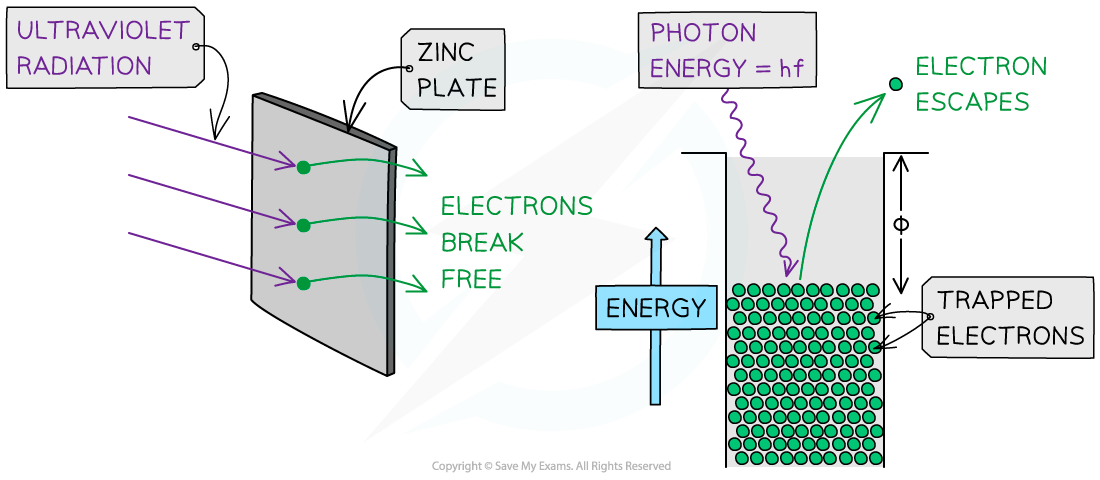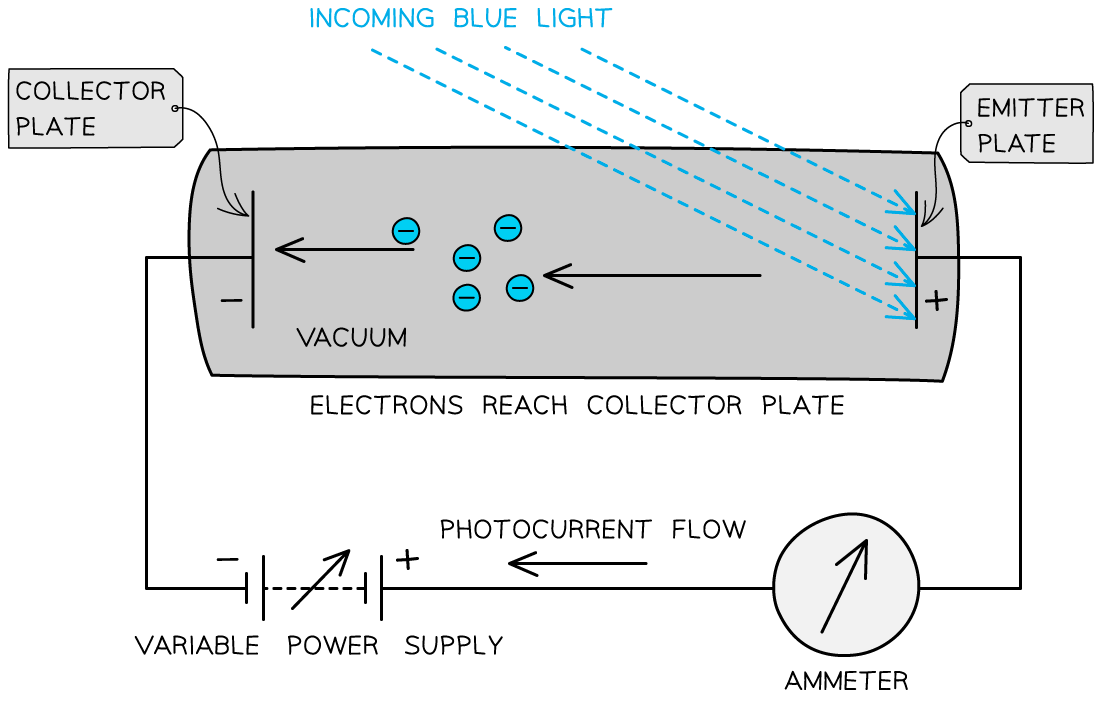Observing the Photoelectric Effect
- The photoelectric effect can be observed on a gold leaf electroscope
- A plate of metal, usually zinc, is attached to a gold leaf, which initially has a negative charge, causing it to be repelled by a central negatively charged rod
- This causes negative charge, or electrons, to build up on the zinc plate
- UV light is shone onto the metal plate, leading to the emission of photoelectrons
- This causes the extra electrons on the central rod and gold leaf to be removed, so, the gold leaf begins to fall back towards the central rod
- This is because they become less negatively charged, and hence repel less
- Some notable observations:
- Placing the UV light source closer to the metal plate causes the gold leaf to fall more quickly
- Using a higher frequency light source does not change the how quickly the gold leaf falls
- Using a filament light source causes no change in the gold leaf’s position
- Using a positively charged plate also causes no change in the gold leaf’s position


Typical set-up of the gold leaf electroscope experiment
Laws of Photoelectric Emission
- The photoelectric effect is evidence that light does not purely behave as a wave
- This is demonstrated by the following observations
- Observation 1:
- Explanation 1:
- Placing the UV source closer to the plate increases the intensity incident on the surface of the metal
- Increasing the intensity, or brightness, of the incident radiation increases the number of photoelectrons emitted per second
- Therefore, the gold leaf loses negative charge more rapidly
- Observation 2:
- Explanation 2:
- The maximum kinetic energy of the emitted electrons increases with the frequency of the incident radiation
- In the case of the photoelectric effect, energy and frequency are independent of the intensity of the radiation
- So, the intensity of the incident radiation affects how quickly the gold leaf falls, not the frequency
- Observation 3:
- Explanation 3:
- If the incident frequency is below a certain threshold frequency, no electrons are emitted, no matter the intensity of the radiation
- A filament light source has a frequency below the threshold frequency of the metal, so, no photoelectrons are released
- Observation 4:
- Explanation 4:
- If the plate is positively charged, that means there is an excess of positive charge on the surface of the metal plate
- Electrons are negatively charged, so they will not be emitted unless they are on the surface of the metal
- Any electrons emitted will be attracted back by positive charges on the surface of the metal
- Observation 5:
- Explanation 5:
- A single photon interacts with a single electron
- If the energy of the photon is equal to the work function of the metal, photoelectrons will be released instantaneously

In the photoelectric effect, a single photon may cause a surface electron to be released if it has sufficient energy
Worked Example
Describe how the photoelectric effect proves the particulate nature of light.
Step 1: Outline what wave theory predicts about the photoelectric effect
-
- Wave theory predicts:
- If radiation strikes a metal surface and ejects an electron, the kinetic energy of the electron should depend on the intensity of the incident wave
- Wave theory predicts:
Step 2: Outline an observation of the photoelectric effect experiment
-
- From observation:
- There is no electron emitted if the frequency of the radiation is below a certain threshold frequency
- The intensity of the radiation does not determine the energy of the emitted electron
- Above the threshold frequency, the maximum kinetic energy of the electrons increases with the frequency of the radiation
- From observation:
Step 3: Suggest how this observation supports the particulate nature of light
-
- This suggests:
- In its interaction with matter, an electromagnetic wave behaves like a stream of particles, or photons
- These photons carry energy which is proportional to the frequency of the radiation
- This suggests:
Stopping Voltage
- Stopping voltage, Vs, is defined as:
The voltage required to stop photoelectron emission from occurring
- The photons arriving at the metal plate cause photoelectrons to be emitted
- This is called the emitter plate
- The electrons that cross the gap are collected at the other metal plate
- This is called the collector plate

This set-up can be used to determine the maximum kinetic energy of the emitted photoelectrons
- The flow of electrons across the gap results in an e.m.f. between the plates that causes a current to flow around the rest of the circuit
- Effectively, it becomes a photoelectric cell producing a photoelectric current
- If the e.m.f. of the variable power supply is initially zero, the circuit operates only on the photoelectric current
- As the supply is turned up, the emitter plate becomes more positive (because it is connected to the positive terminal of the supply)
- As a result, electrons leaving the emitter plate are attracted back towards it
- This is because the p.d. across the tube opposes the motion of the electrons between the plates
- If any electrons escape with enough kinetic energy, they can overcome this attraction and cross to the collector plate
- And if they don't have enough energy, they can't cross the gap
- By increasing the e.m.f. of the supply, eventually, a p.d. will be reached at which no electrons are able to cross the gap – this is the stopping voltage, Vs
- At this point, the energy needed to cross the gap is equal to the maximum kinetic energy KEmax of the electrons
KEmax = eVS
Exam Tip
The observations and explanations of the photoelectric effect are key findings in Physics, which led to a whole new branch of discovery. As such, they are favourites with Examiners. Make sure you have them at your fingertips!
It is important to note that the stopping voltage actually holds a negative value, but since we use it to determine the maximum kinetic energy of the emitted electrons, its sign is not important in calculations, it's acceptable to just quote its magnitude.
